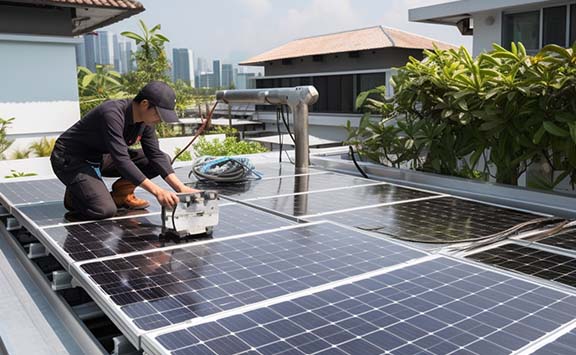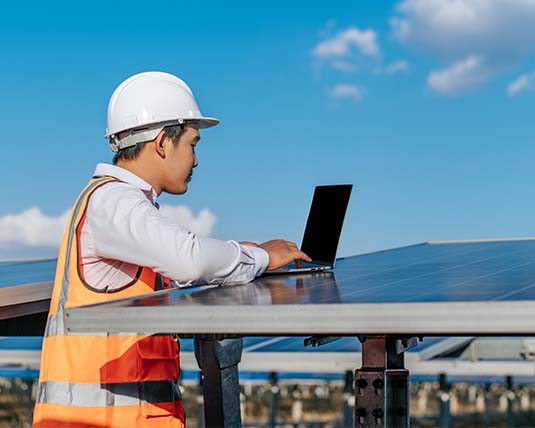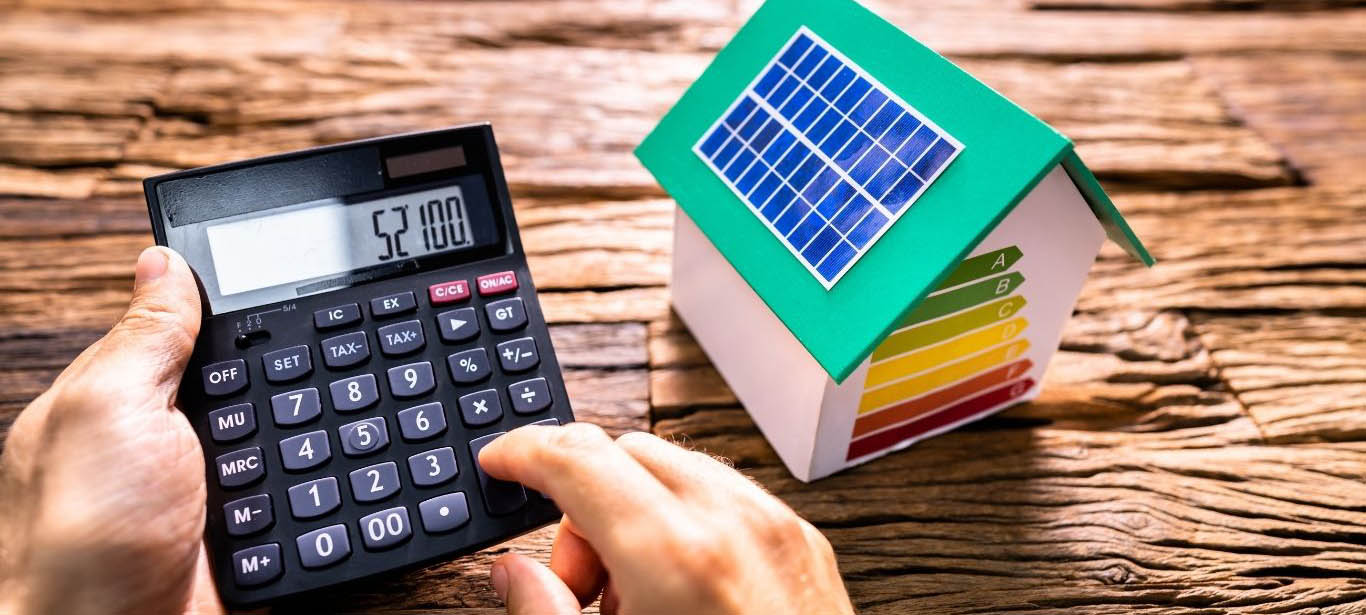
Overview
Introducing solar panels for your home! Get ready to harness the power of the sun and say goodbye to electric bills. In the era of sustainable energy consumption, turn your home in the Philippines into a self-reliant, solar-powered haven, and embrace eco-friendly, cost-effective, and reliable power solutions that won’t let you down.
Advantages Of Solar Energy For Your House
Eco-Friendly
Reduces carbon footprint and promotes a sustainable environment.
Cost Savings
Decreases electricity bills over time with a one-time investment.
Energy Independence
Reduces reliance on the grid, offering power even during outages.
Property Value Boost
Homes with solar installations often see an increase in property value.
Renewable Energy Source
Solar energy is inexhaustible, unlike fossil fuels
Low Maintenance
Once installed, solar panels require minimal upkeep
Scalability
Easy to expand the system based on energy needs
Government Incentives
Governments offer tax breaks & rebates for solar installations
Quiet Energy Production
Solar panels generate energy quietly, unlike other sources.
Reduction in Energy Loss
Shorter energy transportation distances mean less energy loss
Solar Panel Pricing Guide
5kWp Solar PV System
PRICE : ₱ 360,000
Ideal Package for: P8,000 – P12,000 and below/month.
Estimated Annual Production : 7.25MWh.
Estimated Annual Savings: ₱ 65223
Perfect for minimal energy needs, such as small cabins, tiny homes, or specific appliances.
7. 5kWp Solar PV System
PRICE : ₱ 512,500
Ideal Package for: P13,000 – P17,000 and below/month
Estimated Annual Production : 10.61MWh
Estimated Annual Savings: ₱ 95,490
A 7.5 kW system is large enough to run the average home in less-than-average sunlight.
10kWp Solar PV System
PRICE : ₱ 665,000
Ideal Package for: P18,000 – P22,000 and below/month
Estimated Annual Production : 13.98MWh
Estimated Annual Savings: ₱ 125,784
A 10kW solar system produces 13,400-16,700 kWh annually, enough to power an average home for 3 hours.
12.5kWp Solar PV System
PRICE : ₱ 827,500
Ideal Package for: P23,000 – P27,000 and below/month
Estimated Annual Production : 17.54MWh
Estimated Annual Savings: ₱ 157,842
A 12.5 kWp efficiently converts sunlight to electricity and requires 75 m2 of roof space. It is perfect for large homes or appliances that require high power usage.
15kWp Solar PV System
PRICE : ₱ 990,000
Ideal Package for: P28,000 – P32,000 and below/month
Estimated Annual Production : 21.10MWh
Estimated Annual Savings: ₱ 189,900
15 kW solar system produces 60 kWh daily and is suitable for commercial settings. You get 37-45 solar panels which will occupy 75-90 m2 of roof space.
Pros & Cons Of Solar Panels
Pros
Cons
How To Install Solar Panel At Your Home?
Below, we present to you our step-by-step guide to installing solar panels for home and effectively utilizing the sun’s energy for your power needs.

The first step in installing solar panels is letting a professional assess your property to determine its suitability for solar panels. They’ll assess your roof’s structure, angle, and direction and also address potential issues like shading and weather considerations. For more information read our detailed guide to Home Solar Panel Installation
Based on your budget and electricity consumption/requirements, decide on the size and number of solar panels you need. You can contact us for a quick evaluation or even use our solar calculator.
Depending on your locality in the Philippines, you might need to acquire electrical and building permits. Check with your local authorities and ensure you are complying with their regulations to avoid future hassles and complications.
We always advise investing in high-quality solar panels, inverters, and other mounting equipment. Although it can be tempting to invest in cheaper options, quality equipment will be more durable and cost-efficient in the long run.
Mounting: Mounting brackets need to be secured to the roof. Ensure they’re firmly attached and properly sealed to prevent leaks in the future.
Panels: Attach solar panels to the mounting brackets. Ensure they’re angled correctly so that they receive maximum sunlight exposure.
Inverter: Next, install the inverter. This is typically done near the main panel, either outdoors or indoors.
Connections: Connect the solar panels to the inverter using electrical wiring. Ensure all connections are secure and properly insulated.
Grid Connection: If you’re connecting to the grid, this is the step when you’ll integrate your system. An electrician should handle this step.
Once you are done with the installing part, and your solar panels are set up, carry out a test to ensure everything is working fine. Key testing points are to check the inverter’s display for any error messages and ensure the panels are generating power as expected.
Modern solar panel systems like ours come with monitoring software that allows you to track your energy production in real time. Also, regularly check your system for any signs of damage or inefficiency and clean the panels periodically. However, with us, you don’t need to worry. Once your panels are installed and ready to run, we will walk you through the entire maintenance process.
Planning A solar Project Now?
Want to learn more about installing solar panels for home? Contact Nativ Techniks, a leading solar company in the Philippines, for a no-obligation, comprehensive site survey today
Solar calculator
Solar Savings Calculator: Tailor Your Energy Needs & Say Hello to a World of Savings!
Introducing our Solar Savings Calculator! Designed specifically to calculate your solar panel size required for your home or commercial business based on your power requirements. Now you can easily determine the optimal solar system size for your specific electricity bill. What’s more, you can also compare your potential savings with solar power versus traditional energy sources. Experience solar power now and discover how it can benefit both you and our planet.

Solar Power FAQ
The short answer to this question is No. Solar panels need sunlight to work, and thus, they cannot work at night. They function only during the day when there is sunlight present to transfer it into electrical energy.
Solar panels can significantly reduce electricity bills, often by 50% to 90%, depending on the system size, location, local electricity rates, and solar insolation. Over time, as electricity prices rise, the savings can be even greater. Additionally, with net metering, excess energy generated can be sold back to the grid, further offsetting costs. However, exact savings vary based on individual circumstances
Solar panels have a significant power output and can definitely run an air conditioner. However, you should keep in mind that the wattage of the solar panels you need to run your AC will depend on the tonnage of your AC unit. For example, if you have a 1.5-ton AC, you might need to get a 2.5kW or 3kW panel.
The minimum requirement for solar panels includes factors like:
- A space that has access to direct sunlight
- 1kW requires around 6 square meters of space
- Financial considerations that depend on the number of panels and their wattage
Thus, if you are planning to buy solar panelsfor home you should keep the above points in mind.
For an air conditioner, you will need to calculate the amount of power it will consume. A typical air conditioner will use 1200 to 1500 watts of power. Thus, if your solar panel is capable of generating 250 watts of power, then you will need 6 solar panels. Larger air conditioning units will require more solar panels. You can use our solar panel calculator to find the exact number of panels you will need.
To determine the number of panels you will need to run a refrigerator, you will need to calculate its power consumption. If you want to power a 300W refrigerator, your solar panel system should generate around 7.2kW of power every day. Thus, for this, you will need 3-4 solar panels to run your refrigerator.
To determine the amount of power you will need to run a house, you will need to keep certain factors in mind like the climate of your area, its location, and the household usage.
Moreover, you need to consider other factors like:
- The average power consumption of your house
- The size of your house
- No of electrical appliances you will use
To have an approximate idea about the power usage, a normal-sized house will use around 3-5kW of solar power to run.
The number of appliances you can run on solar depends on certain factors like:
- The capacity of your solar power system
- Battery storage
- Power consumption of the appliances
Moreover, the specific number of appliances that you can power with your solar panel also varies. For an exact number you need to calculate your energy consumption and use a solar calculator to find out the number of solar panels you need.
According to experts the best batteries to use for solar panels are lithium-ion batteries. Their cycle life is higher as compared to batteries that run on lead acid. Although they are more expensive than other battery types, their longevity and efficacy make them a popular choice, and they are used in both on-grid and off-grid systems.
A 7kW solar power system may be sufficient to power small homes that don’t use a lot of electrical appliances. If the house is larger or there are several electrical appliances present then it can cover around half of the house’s energy requirements.
A 10kW solar power system can cover an average-sized home that has a family of 4 and measures around 2,000 square feet. However, it’s important to consider other factors like the climate of the place the house is situated in and the number of electric appliances it is running.
A 8kW power system can run a 1,000-square-foot house easily. It is enough to power typical appliances like a refrigerator, lighting, and an air conditioner. It also depends on the energy consumption of the house and the power requirements of the appliances in use.
It is not recommended to connect a solar panel directly to a battery as it can cause damage to the battery. Thus, you should consider using a solar charging controller to regulate the charging process and protect your battery against overcharging.
A general rule of thumb is that every square foot of space on your roof has the capacity to generate around 15 watts of solar power energy. Thus, if you have a small home then you will need only 200 square feet of space on your roof. However, if you have a larger home then you will need more than 1000 square feet of roof space to generate adequate power for your home.


